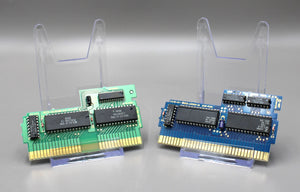The Historical Tetris Saga: From Soviet Origins to Gaming Phenomen!
Introduction to Tetris:
Tetris, the iconic puzzle video game, has become synonymous with gaming itself since its release in 1984. It’s simple yet addictive gameplay, where players rotate and place falling blocks (tetrominoes) to create complete lines, has captivated millions worldwide. But the story of Tetris is as complex as its gameplay, spanning international boundaries and significant legal battles.
Development and Early History:
Tetris was developed by Alexey Pajitnov, a Russian computer scientist, while working at the Dorodnitsyn Computing Centre of the Soviet Academy of Sciences. Pajitnov's goal was to create a game that could showcase the capabilities of the then-nascent personal computers. The first version of Tetris ran on an Electronika 60, a Soviet computer, and was inspired by a traditional puzzle game called Pentominoes. Its innovative design quickly caught the attention of other programmers and gamers.
Atari's Involvement:
In the late 1980s, Tetris began to gain international fame, leading to interest from various companies. Atari, recognizing the game's potential, sought to secure the rights to develop a home console version. However, this ownership became tangled in complex licensing disputes. At that time, the rights to Tetris were held by the Soviet Union and not the actual individual developer Alexey Pajitnov, making negotiations intricate due to political and bureaucratic hurdles. Remember the United States and the Soviet Union were still involved in the Cold War until 1989.
Nintendo's Acquisition:
In 1989, Nintendo entered the fray, ultimately securing the rights to develop and publish Tetris for its Game Boy and NES consoles. This acquisition was facilitated through a deal with the Soviet Union, specifically with the government-owned software company Elorg. Nintendo's Game Boy version of Tetris, released in 1989, became a massive success, propelling the handheld console to popularity and cementing Tetris as a gaming classic. The Game Boy handheld console was often paired with Tetris, not unlike the Sega Genesis console and Sonic The Hedgehog, they go hand in hand!
Nintendo Licensed vs. Atari Unlicensed Cartridges
As Tetris gained popularity, various unauthorized versions began to emerge. These unlicensed cartridges were developed by companies that did not hold the rights to the game, leading to a variety of adaptations on different platforms. The contrast between licensed and unlicensed cartridges has significant implications for collectors:
- Licensed NES Cartridges (Grey): This version of Tetris, produced with the appropriate rights and approvals, are typically of higher quality and feature official branding. The NES standard loose grey cartridges run for about $10 to $20, depending on the condition.
- Unlicensed NES Cartridges (Black): You may have heard of Tengen! Atari Games created Tengen as a company to develop and publish video games. Due to the rarity this black cartridge version of Tetris, this game usually runs for about ranging from $80 to $150, depending on the condition. This copy looks much different than the licensed version we see in every game store. The game is black with a reddish label that states, “The Soviet Mind Game,” and a backwards R in Tetris. Not many of these copies hit the sales floor because Nintendo acquired the actual rights and these were immediately pulled due to licensing.
Tetris is not just a game; it’s a piece of gaming history that reflects the intersection of technology, culture, and politics. From its somewhat simple beginnings in the Soviet Union to trade negotiations with some gaming power players to its global success and the complexities of rights ownership, the story of Tetris underscores the transformative power of video games. For collectors and enthusiasts alike, understanding the nuances between licensed and unlicensed versions adds another layer of appreciation for this timeless classic. As Tetris continues to evolve through remakes and adaptations, its legacy remains firmly rooted in its origins, reminding us of the joy of puzzle-solving and creativity.
Happy gaming! Feel free to comment with your own thoughts or questions.
- Lauren @ Video Game Gem Vault
Contact Video Game Gem Vault
play@videogamegemvault.com or
Call/Text: 269-213-5006
We'd love to hear from ya!



